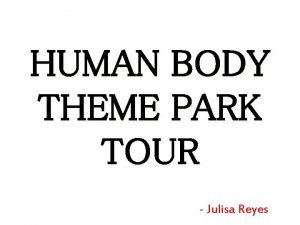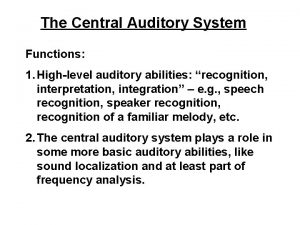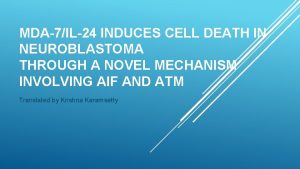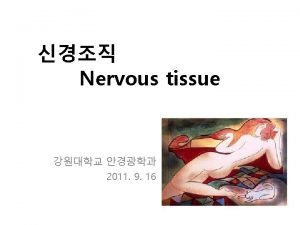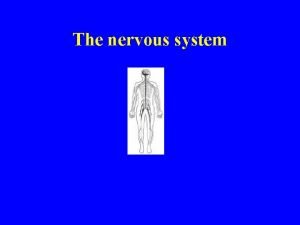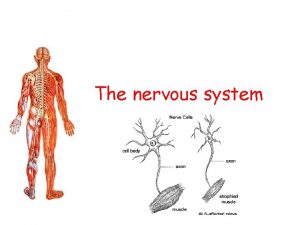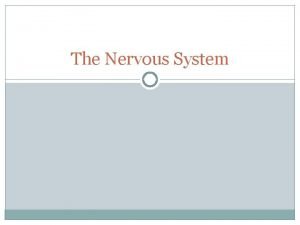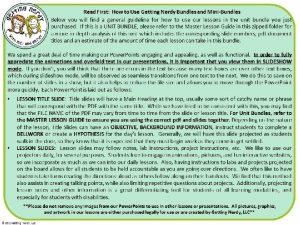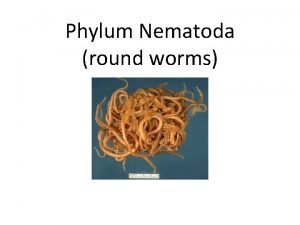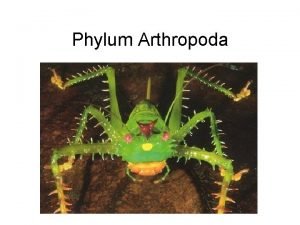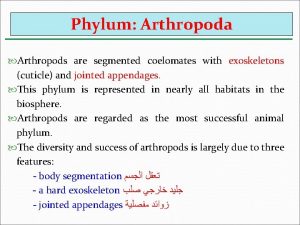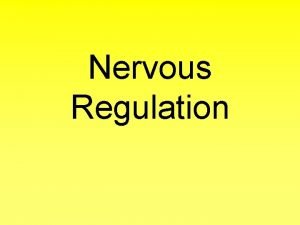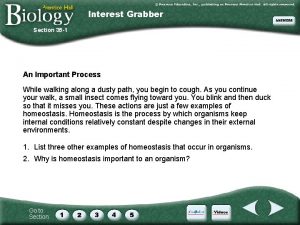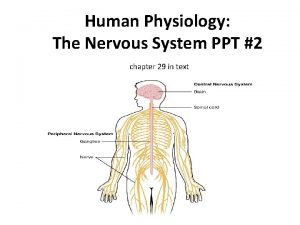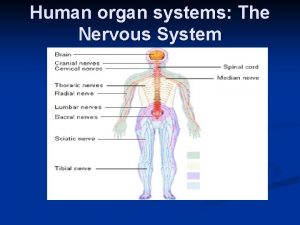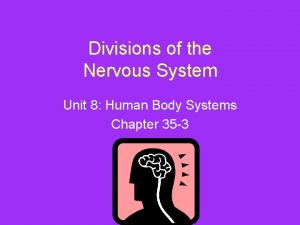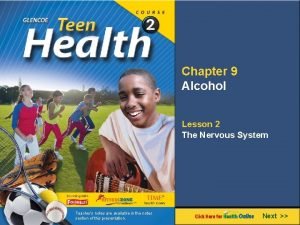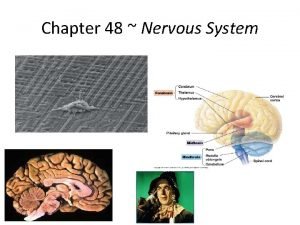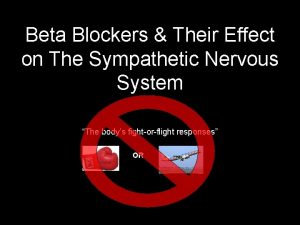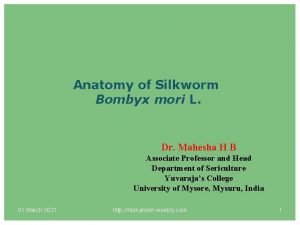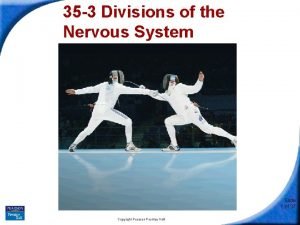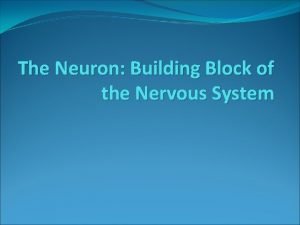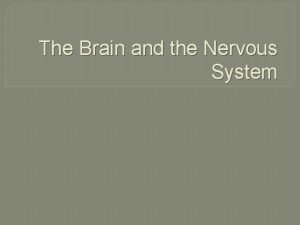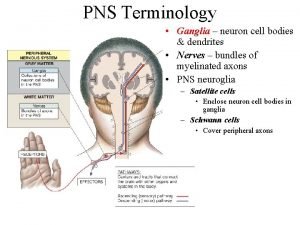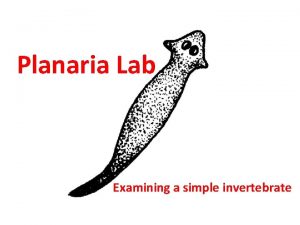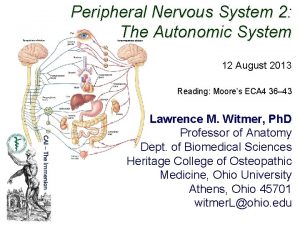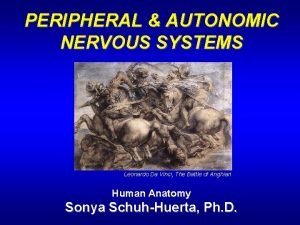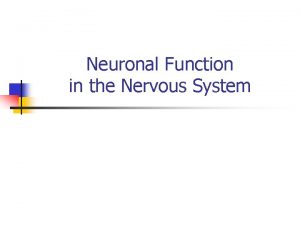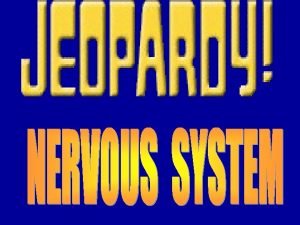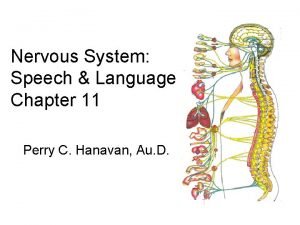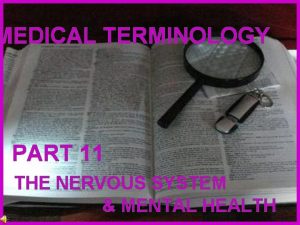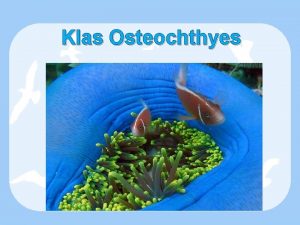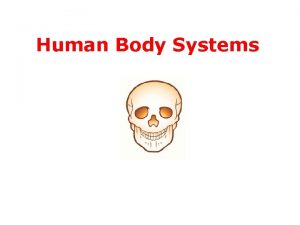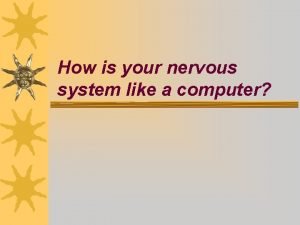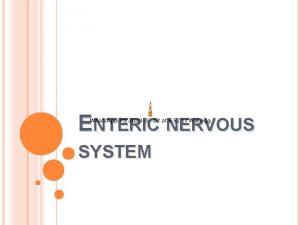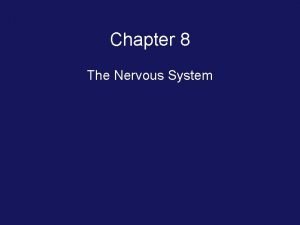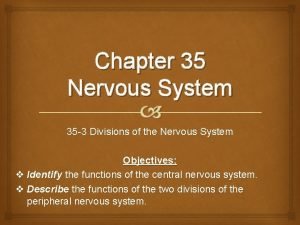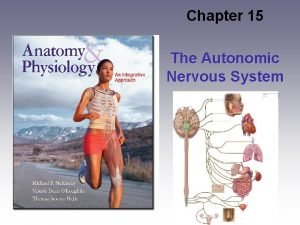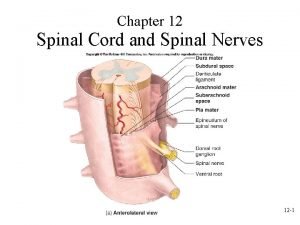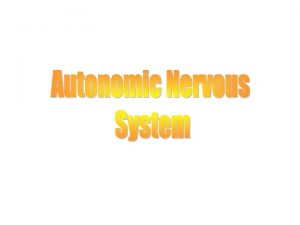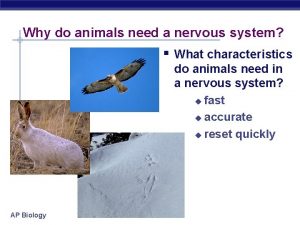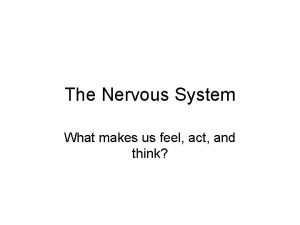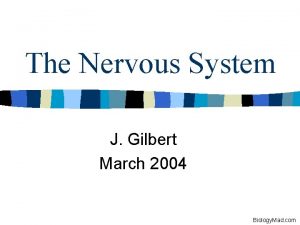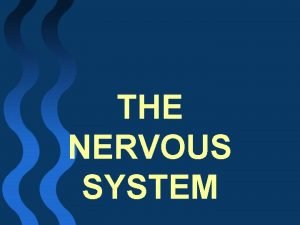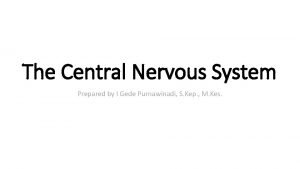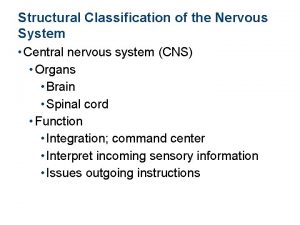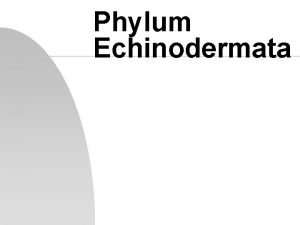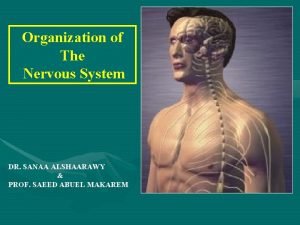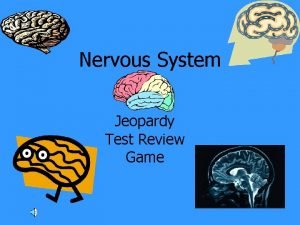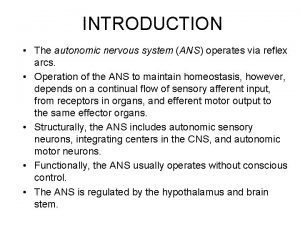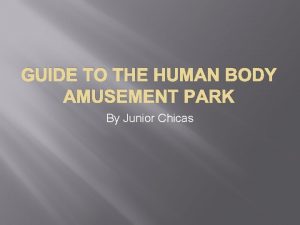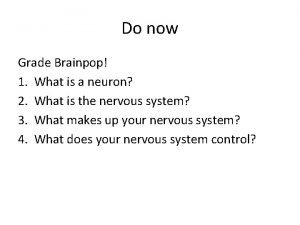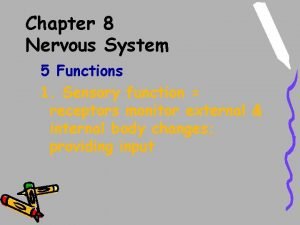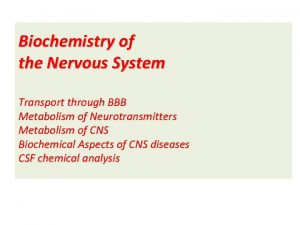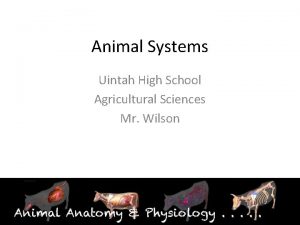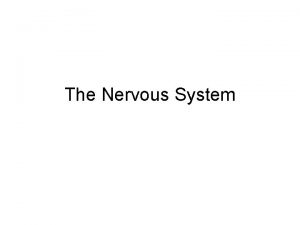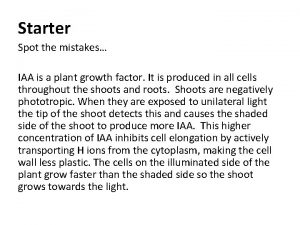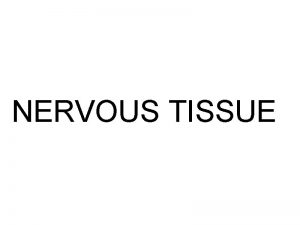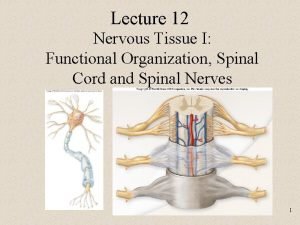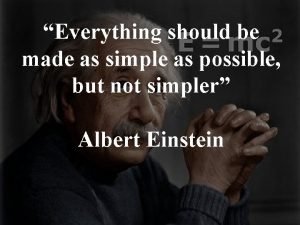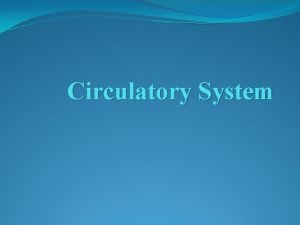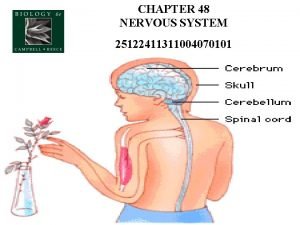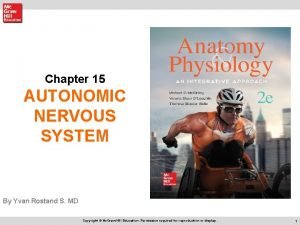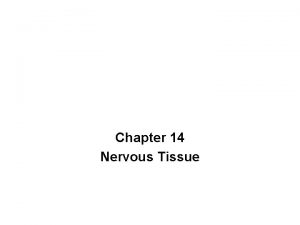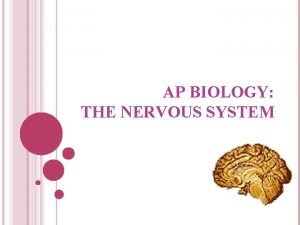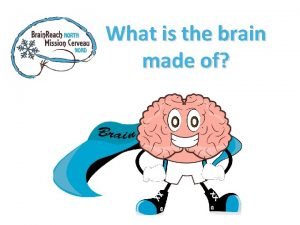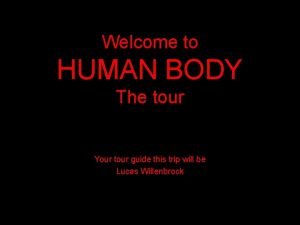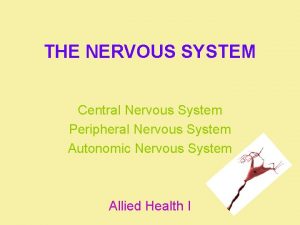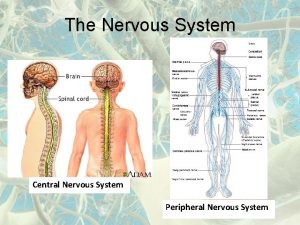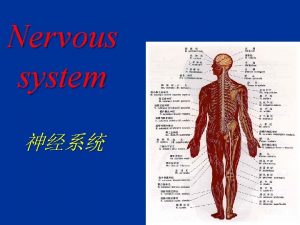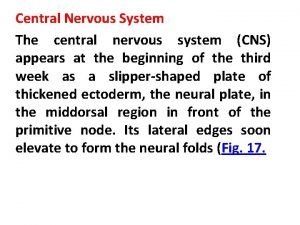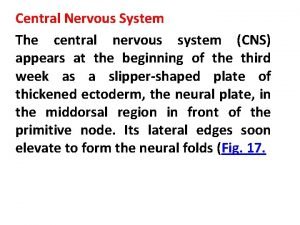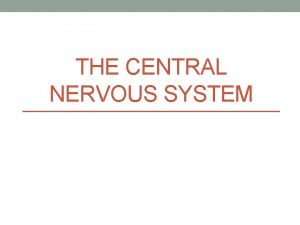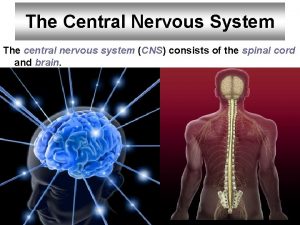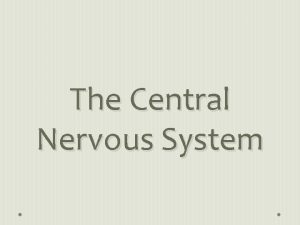The Central Nervous System The Central Nervous System











































































































- Slides: 107

The Central Nervous System




The Central Nervous System • The Central Nervous System processes all of the body’s information and includes the brain and the spinal cord

The Peripheral Nervous System • The Peripheral Nervous System includes all of the other nerves in the body • The Peripheral Nervous System is divided into two categories: • The Somatic Nervous System • The Autonomic Nervous System

The Somatic Nervous System • The Somatic Nervous System connects the brain to the muscles of the body. • controls all of our voluntary muscle movements. • It is connected to the motor cortex in the brain.

The Autonomic Nervous System • The Autonomic Nervous System controls the automatic functions of the body and connects the brain to the heart, lungs, internal organs, glands, etc.

The Autonomic Nervous System • This system is also responsible for actions associated with stress and perceived threats. The autonomic system is further broken down into two systems: • Sympathetic Nervous System • Parasympathetic Nervous System

The Sympathetic Nervous System • The Sympathetic Nervous System mobilizes the body to respond to stress. It is our alert (fight) system. • Accelerates the heart, blood pressure, respiration) • Conserves energy for fight by slowing down digestion, etc.

The Parasympathetic Nervous System • The Parasympathetic Nervous System returns the body to a normal state after a stressful encounter.


THE BRAIN


How Do We Study The Brain?

• Electroencephalogram (EEG) • Electrodes are placed on the scalp that amplify recordings of the waves of electrical activity across the brain’s surface



• Computed Tomography (CT or CAT Scan) • A series of X-ray photographs taken from different angles and combined by computer into a composite representation of the brain



• Positron Emission Tomography (PET Scan) • A visual display of brain activity that detects where a radioactive form of glucose goes while the brain performs a given task




• Magnetic Resonance Imaging (MRI) • A technique that uses magnetic fields and radio waves to produce computergenerated images that allow us to see structures within the



• Accidents • Case study analysis of victims of suffer from a brain injury, resulting in variations in normal behavior • IE. Phineas Gage

• Lesions • Lesioning is the removal or destruction of part of the brain. • IE. Lobotomy

THE BRAIN AND ITS FUNCTIONS

I. The Hindbrain


• The hindbrain is the oldest and innermost region of the brain

• The functions of the hindbrain are mostly done outside of our awareness, and occur without any conscious effort.

• The functions of the hindbrain control basic biological functions that keep the human body alive.

• There are three brain areas associated with the Hindbrain: • Medulla • Cerebellum • Pons

• The point at which the spinal cord enters the skull is called the MEDULLA • The MEDULLA controls heartbeat and breathing, blood pressure, and attention



• Extending from the rear of the brainstem is the CEREBELLUM • The CEREBELLUM coordinates voluntary movements and balance (along with the BASIL GANGLIA)



• The PONS is responsible for helping to regulate breathing, to help with sleep and wake cycles, and controls facial expressions


II. The Midbrain • The Midbrain is located between the hindbrain and the forebrain • This area is responsible for coordinating simple muscle movements with changes in sensory information

• The major area of the Midbrain is the RETICULAR FORMATION • The RETICULAR FORMATION extends from the spine to the thalamus, and is responsible for arousal/wakefulness and attentiveness


• The MIDBRAIN is also responsible for behaviors associated with hearing and sight • Pupil dilation and eyeball movement



III. The Forebrain • Areas of the forebrain control thought and reason. • There are five main regions of the forebrain to study: • Thalamus • Hypothalamus • Amygdala • Hippocampus • The Cerebral Cortex

• On top of the hindbrain is the THALAMUS • The THALAMUS receives sensory input from all of the senses except smell, and routes it to the proper area of the brain for processing • The THALAMUS also helps to control the electrical currents in the brain



• The HYPOTHALAMUS is responsible for several maintenance activities, including eating, drinking, body temperature, and sexual arousal

• The HYPOTHALAMUS also relays communication between the brain and the endocrine system, via the pituitary gland, and then monitors the hormones released into the bloodstream



• The HIPPOCAMPUS is essential to memory processing



• The AMYGDALA is tied to emotions, especially those of aggression, rage, and fear



• Collectively, the thalamus, hypothalamus, hippocampus, and the amygdala are known as the Limbic System as well




• The CEREBRAL CORTEX is the intricate, wrinkled covering of the brain (FISSURES) (actually a bump is a gyrus and a groove is a sulcus – but that’s a bit too much info…) • In addition to interneurons, it contains GLIAL CELLS, which guide neural connections, provide nutrients to myelin, and mop up neurotransmitters




• The Cerebral Cortex is split into two halves, or Hemispheres: • Right Hemisphere • Left Hemisphere

• The two hemispheres of the brain are connected by the CORPUS CALLOSUM

Hemispheres of the Brain





• Each hemisphere of the brain has different functions. This is called hemispheric specialization.



• The Cerebral Cortex is split into four LOBES, with half of each one on the left, and half of each one on the right: • The FRONTAL LOBE PARIETAL LOBE OCCIPITAL LOBE TEMPORAL LOBE



• The Frontal Lobes are the portions of the cortex lying just behind the forehead • Mostly involved in abstract thought, speaking, muscle movements, making plans, and judgments

• In the left frontal lobe specifically, there is an association area responsible for language processing called Broca’s Area

• Broca’s Area controls language expression and the muscle’s involved with producing speech

• Along the top of both front lobes runs the motor cortex

• The motor cortex receives messages from the rest of the brain and then sends messages back to the muscles of the body in order to control voluntary movements.



• The Parietal Lobes are the portion of the cortex lying at the top of the head includes the sensory (or somato-sensory) cortex

• The parietal lobes play important roles in integrating sensory touch information, and in the handling and manipulation of objects.

• The sensory cortex registers and processes touch sensations.

• Click the homunculus to understand the homunculus! http: //faculty. washington. edu/chudler/flash/hom. html



• The Temporal Lobes are the portions of the cerebral cortex roughly located above the ears • audio processing • comprehension, naming, verbal memory and other language functions.

• In the left temporal lobe specifically, there is an association area responsible for language processing called Wernike’s Area

• Wernicke’s Area interprets both written and spoken language.


• The Occipital Lobes are located at the back of the head • The occipital lobe is responsible for processing visual information.

Module 8: The Brain Plasticity

Plasticity • The ability of the brain tissue to take on new functions • Greatest in childhood • Important if parts of the brain are damaged or destroyed • Go to the next slide to see a video about brain plasticity! (may take a few seconds to load – be patient – click only once to load the video – then wait!

 Label the different types of neuronal pools in the figure.
Label the different types of neuronal pools in the figure. Fundamentals of the nervous system and nervous tissue
Fundamentals of the nervous system and nervous tissue Neuronal processes
Neuronal processes Nervous system major divisions
Nervous system major divisions Central nervous system amusement park
Central nervous system amusement park Central nervous system parts
Central nervous system parts Nervous tissue
Nervous tissue Central and peripheral nervous system
Central and peripheral nervous system Central auditory nervous system
Central auditory nervous system Electrical synapse vs chemical synapse
Electrical synapse vs chemical synapse Central nervous system for kids
Central nervous system for kids Central nervous sysytem
Central nervous sysytem Nervous system and digestive system
Nervous system and digestive system Endocrine system and nervous system
Endocrine system and nervous system Endo crine gland
Endo crine gland Endocrine system
Endocrine system Chemical messengers of the nervous system
Chemical messengers of the nervous system Is flatworm asexual reproduction
Is flatworm asexual reproduction The nervous system is made up of
The nervous system is made up of Neuron anatomy
Neuron anatomy Nervous system learning objectives
Nervous system learning objectives Bipolar neuron function
Bipolar neuron function What is stimuli in nervous system
What is stimuli in nervous system Neuron bundle
Neuron bundle Parasympathetic and sympathetic
Parasympathetic and sympathetic Sympathetic tone definition
Sympathetic tone definition Number of spinal nerves
Number of spinal nerves Sns pg
Sns pg Brain scienstructable
Brain scienstructable Autonomic nervous system skeletal muscle
Autonomic nervous system skeletal muscle Roundworms nervous system
Roundworms nervous system Subphylum
Subphylum Nervous system of arthropods
Nervous system of arthropods Segmented coelomates
Segmented coelomates Parasympathatic nervous system
Parasympathatic nervous system Nervous system of coelenterata
Nervous system of coelenterata Autonomic nervous system consists of
Autonomic nervous system consists of Differences between nervous system and endocrine
Differences between nervous system and endocrine Section 35-1 human body systems answer key
Section 35-1 human body systems answer key Somatic and autonomic nervous system
Somatic and autonomic nervous system The nervous system
The nervous system Basic unit of nervous system
Basic unit of nervous system The basic unit of the nervous system is the
The basic unit of the nervous system is the Nervous tissue ppt
Nervous tissue ppt What is the difference between gray and grey
What is the difference between gray and grey Comparison of endocrine and nervous system
Comparison of endocrine and nervous system 8 divisions of the nervous system
8 divisions of the nervous system How to take care of your nervous system
How to take care of your nervous system Nervous system effector cells
Nervous system effector cells Chapter 15 nervous system diseases and disorders
Chapter 15 nervous system diseases and disorders Exocrine glands are ductless
Exocrine glands are ductless Beta-blockers for overactive sympathetic nervous system
Beta-blockers for overactive sympathetic nervous system Somatic motor function
Somatic motor function Visceral reflex
Visceral reflex Bombyx mori anatomy
Bombyx mori anatomy 35-3 divisions of the nervous system
35-3 divisions of the nervous system Building block of the nervous system
Building block of the nervous system Structure of nervous system graphic organizer
Structure of nervous system graphic organizer Ganglion peripheral nervous system
Ganglion peripheral nervous system Planaria classification
Planaria classification Cnidaria
Cnidaria Diff between sympathetic and parasympathetic
Diff between sympathetic and parasympathetic Sympathetic and parasympathetic nervous system difference
Sympathetic and parasympathetic nervous system difference Nervous
Nervous Divisions of the nervous system
Divisions of the nervous system Limb apraxia
Limb apraxia Disorders of the nervous system
Disorders of the nervous system Sistem pencernaan osteichthyes
Sistem pencernaan osteichthyes Smoking damages your lungs
Smoking damages your lungs Nervous system of computer
Nervous system of computer Enteric plexus
Enteric plexus Chromaffin cells
Chromaffin cells Chapter 8 the nervous system
Chapter 8 the nervous system Nervous system
Nervous system 35-3 divisions of the nervous system
35-3 divisions of the nervous system Autonomic nervous system
Autonomic nervous system Functional unit of nervous system
Functional unit of nervous system Body system amusement park names
Body system amusement park names The autonomic nervous system controls
The autonomic nervous system controls Why do animals need a nervous system
Why do animals need a nervous system Enmeshment
Enmeshment Nervous system function
Nervous system function The human nervous system biology mad
The human nervous system biology mad Somatic nervous system
Somatic nervous system Sensory vs motor homunculus
Sensory vs motor homunculus Structural classification of the nervous system
Structural classification of the nervous system Brittle stars phylum
Brittle stars phylum Parts of the brain
Parts of the brain Jeopardy nervous system
Jeopardy nervous system Introduction of nervous system
Introduction of nervous system Human body amusement park
Human body amusement park Brainpop nervous system
Brainpop nervous system 5 functions of the nervous system
5 functions of the nervous system Biochemistry of nervous system
Biochemistry of nervous system What is the job of the nervous system
What is the job of the nervous system Peripheral nervous system
Peripheral nervous system Organisation of nervous system
Organisation of nervous system Nervous system communication
Nervous system communication Nervous system parts
Nervous system parts Functional nervous system
Functional nervous system Nervous system
Nervous system Functional organisation of nervous system
Functional organisation of nervous system Nervous system homeostasis
Nervous system homeostasis Autonomic dysreflexia
Autonomic dysreflexia Neurolemmocyte
Neurolemmocyte Ap biology nervous system
Ap biology nervous system Nervous system
Nervous system Tour of body.com
Tour of body.com




